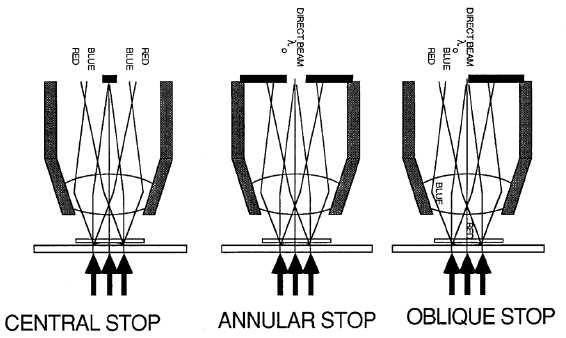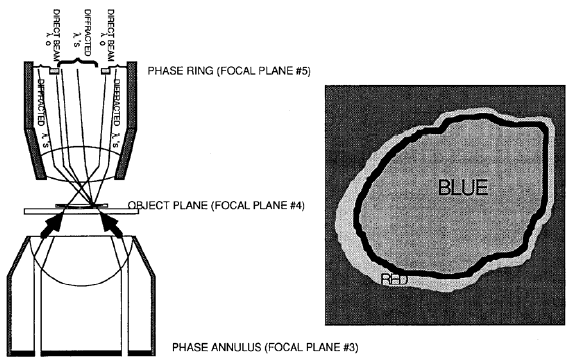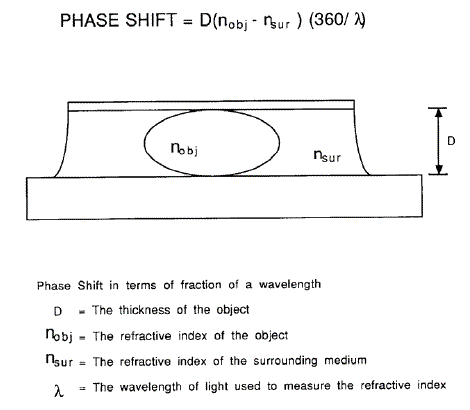INTRODUCTION TO DISPERSION STAINING
MICROSCOPY http://www.microlabnw.com/index/DispersionStaining1989.pdf
Crutcher,E.R.,III氏による。1989年、8p。
Dispersion staining is a group of analytical techniques based
on the analytical interpretation of color effects resulting from
differences in the rate of change of the refractive index with
wavelength (dispersion) between a standard material and an unknown.
It is an optical effect and does not involve a chemical reaction
or require a chemical affinity as do chemical staining techniques.
Dispersion staining has been widely used in the study of everything
from dental caries to hazardous materials identification.
Significant advances in the technique of free particle analysis
have occurred since the last major study of dispersion staining
by G. B. Hoidale. That study, conducted in 1964, provided a description
of dispersion staining as it was understood at that time and included
an extensive list of references. In the intervening years dispersion
staining has been much more widely applied as an analytical technique.
There is now a better appreciation of the material properties
underlying the dispersion of the refractive index and there have
been many improvements in the detection and characterization of
these properties.
The dispersion of a material is related to the nature of the bond
energies between ions in the molecules of that material and the
energy of the wavelength of light used to measure those properties.
The dispersion of a material is typically plotted on a graph with
the abcissa being the refractive index and the ordinate being
the wavelength scaled as a function of the reciprocal of the wavelength
squared (see Figure 1). Bond energies between three and five electron
volts result in a very steep dispersion curve. Materials with
higher bond energies have dispersion curves with a more horizontal
slope, as the bond energies increase the slope of the dispersion
curve decreases.
There are five basic methods of dispersion staining. These are
Becke’ line dispersion staining, oblique illumination dispersion
staining, condenser stop dispersion staining, objective stop dispersion
staining, and phase contrast dispersion staining.
Becke’ line dispersion staining was first documented in 1911 by
F. E. Wright. He referred to the colored Becke’ lines that could
be seen around a particle when the refractive index of the particle
and that of the surrounding liquid in which it was mounted matched
for some visible wavelengths but not for others. Figures 2 and
3 illustrate the path of a parallel bundle of rays (substage condenser
iris closed down) through a particle mounted in a liquid of lower
and of higher refractive index respectively. Figure 4 shows the
appearance of the Becke’ line as the plane of focus is moved above
that of the edge of the particle by defocusing the microscope.
The Becke’ Line is the bright band of light that moves into the
particle if the particle has the higher refractive index or out
into the surrounding liquid if the liquid has the higher refractive
index. If the refractive index of the particle (nobj) and the
liquid (nsur) match at one wavelength (λ0)
but the liquid has a steeper dispersion curve than the solid (generally
the case) then two Becke’ lines are created (see Figure 5). The
Becke’ line moving into the particle is the combination of all
of the wavelengths for which the particle has the higher refractive
index. These are all the wavelengths toward the red end of the
spectrum from the matching wavelength. The color of this Becke’
line will vary from pale yellow if λ0 is
in the deep blue to dark red if λ 0 is in the orange-red part
of the spectrum. The Becke’ line that moves into the surrounding
liquid is the combination of all the wavelengths for which the
liquid has the higher refractive index. These are all the wavelengths
toward the blue end of the spectrum from the matching wavelength.
The color of this Becke’ Line will vary from deep blue if λ 0
is in the blue part of the spectrum to pale blue if λ0
is in the orange-red part of the spectrum.
Wright also proposed the oblique illumination method. The colors
created are the same but they color significant areas of the opposite
sides of the particle when the particle is in sharp focus (see
Figure 6). By using a narrow range of angles for the oblique illumination
this technique can be very effective and has the advantage of
keeping the particle sharply in view and of creating a larger
colored area which is easier to interpret.
Another dispersion staining method was introduced by G. C. Crossmon
during the 1940’s. It involved the use of a darkfield stop in
the substage condenser of the microscope. A further improvement
of this method was made during the 1970’s by using a more limited
cone of illumination (R. G. Speight). This was accomplished by
using a phase annulus (see Figure 7) rather than the simpler darkfield
stop. The particle appears on a black background in the complimentary
color to that of the matching wavelength. The color ranges from
pale yellow, to gold, to shades of magenta, and finally to blue
as λ0 moves from deep blue (400 nanometers)
through dark red (700 nanometers).
In the 1950’s Yu. A. Cherkasov in the Soviet Union devised another
technique. He began by noting the distribution of the rays that
gave rise to the colored Becke’ lines as they passed through the
back focal plane of the objective (see Figure 8). By placing opaque
screens of different configurations at the back focal plane he
could control which set of rays could pass to create the final
image of the object (see Figure 9). This technique was further
developed by K. M. Brown and Walter McCrone and is the most common
dispersion staining technique used today, though often not the
most appropriate. The color sequence when a central stop is used
is the same as that for the condenser stop technique above but
this technique is more sensitive to smaller particles and generates
brighter colors. One disadvantage is the greater loss of resolving
power, the shape of object is more difficult to see. When the
oblique stop is used the color sequence is the same as for oblique
illumination with the same advantages and disadvantages noted
for the central stop. The annular stop creates a particle image
in the wavelength for which the liquid and the particle match
in refractive index in theory. In fact the matching refractive
index is mixed with the direct ray and a green color dominates
the series of colors that is difficult to characterize as to the
location of the matching wavelength. The central stop is almost
exclusively used when objective stop dispersion staining is applied.
In the late 1950’s and early 1960’s K. G. Schmidt in Germany wrote
a paper on the color effects seen when using phase contrast microscopy
(see Figure 10). These effects were due to the combination of
dispersion and the phase shift in the rays of light passing through
the particle compared to those passing through the mounting medium.
His papers noted the effects but did not explain the origin of
the colors. As a result his observations were not generally repeatable.
The dependence of the phase shift as a function of particle thickness
(see Figure 11) was the principle parameter missing in Schmitt’s
work. For particles less than ten micrometers in thickness a reliable
and repeatable sequence of colors is created that can be used
to determine the wavelength at which a particle and its surrounding
mounting liquid match. The sequence of colors is basically the
same as for the colored Becke’ Lines except the blue colors become
the color of the entire particle and the red colors become a halo
around the particle. This system has the advantage of showing
the color effect without any loss of resolving power in the image.
This technique is a significant addition to dispersion staining
test procedures and is vastly superior to the objective stop method
for the characterization of small particles or fibers as in the
analysis of asbestos.
The literature on dispersion staining methods is woefully deficient
in detailed descriptions of the mechanisms involved. Cherkosov’s
paper on objective stop methods and a paper by Speight on condenser
stop methods are two notable exceptions. Dispersion staining methods
are being widely applied, not just for bulk asbestos analysis
but for other types of analysis also (E. R. Crutcher).
REFERENCES
- 1. Hoidale, G. B., U.S. ARMY MICROFICHE, AD 603 019, 1964.
- 2. Wright, F. E., Publication No. 158, Carnegie Inst., Washington,
D. C., pp. 87-, 1911.
- 3. Crossmon, G. C. “Microscopical Distribution of Corundum
Among its Natural and Artificial Associates”, ANALYTICAL CHEMISTRY,
Vol. 20, No. 10, 1948.
- 4. Speight, Richard G., “An Alternative Dispersion Staining
Technique”, THE MICROSCOPE, Vol. 25, 1977.
- 5. Cherkasov, Yu. A., “Application of ‘Focal Screening’ to
Measurements of Indices of Refraction by the Immersion Method”,
INTERNATIONAL GEOLOGICAL REVIEW, Vol.2,1960.
- 6. Brown, K. M. and W. C. McCrone, “Dispersion Staining”,
THE MICROSCOPE, Vol. 13 and 14, 1963.
- 7. Schmidt, K. 0., “Phase Contrast Microscopy and Dispersion
Staining”,STAUB, Vol. 18, 1958.
- 8. Crutcher, E. R., “The Role of Light Microscopy in Aerospace
Analytical Laboratories”, PROCEEDINGS OF THE NINTH SPACE SIMULATION
SYMPOSIUM, 1977.
- 9. Crutcher, E. R., “Optical Microscopy: An Important Tool
for Particulate Receptor Source Apportionment”, PROCEEDINGS OF
THE AIR POLLUTION CONTROL ASSOCIATION, 1981.

|
Dispersion Staining Color by the Value of λ0
The top bar shows the color that corresponds to the λ0 match for central stop and Darkfield dispersion
staining. The two lower bars show the two colors that are seen
with colored Becke Line, Oblique, and Phase Contrast dispersion
staining for a corresponding λ0. The colors
will vary a bit depending on the specific configuration of the
microscope and the relative shape of the dispersion curves. |

Fig.1: Dispersion curves for high density liquids and optical
glass standards
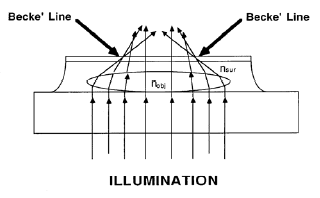
Fig.2: Light path through particle, refractive index of particle
greater than liquid
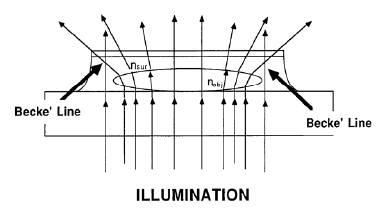
Fig.3: Light path through particle, refractive index of particle
less than liquid
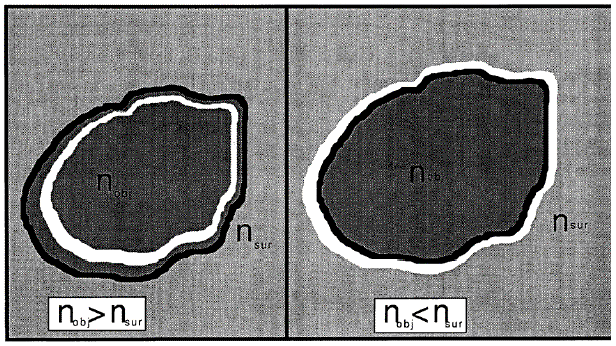
Fig.4: Becke' lines
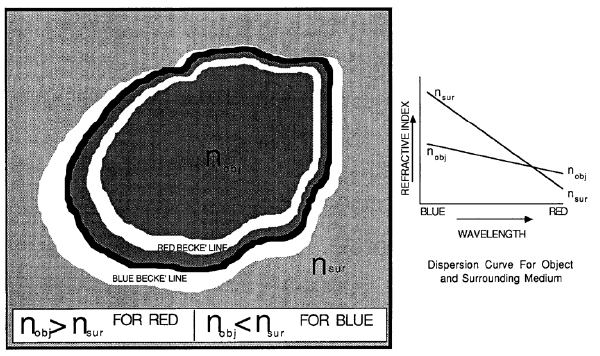
Fig.5: Becke' lines dispersion staining
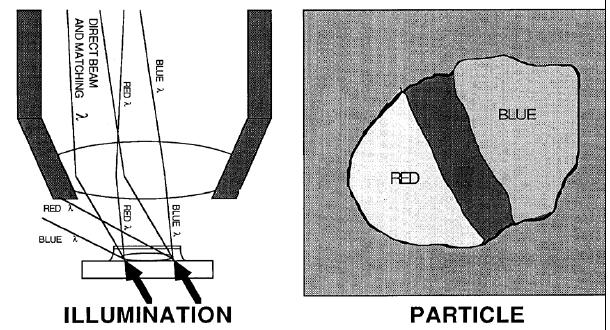
Fig.6: Oblique illumination dispersion staining
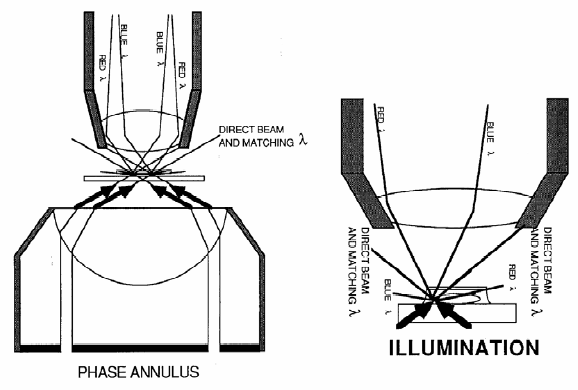
Fig.7: Condenser stop dispersion staining
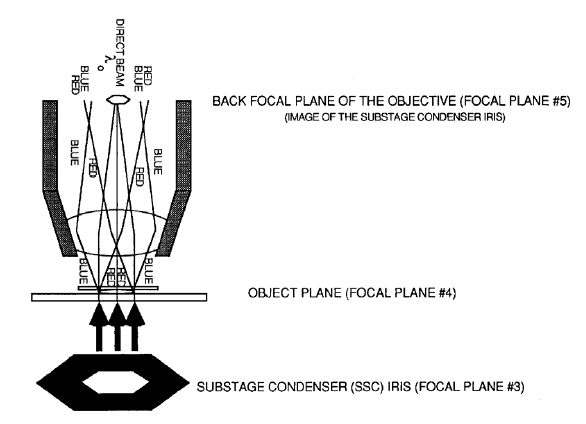
Fig.8: Wavelength distribution about λ0
caused by dispersion, SSC iris closed
Crutcher(1989)による『Introduction
to dispersion staining microscopy』から |
戻る









